|
Satori MW16P-4 Review
The Satori is the top of the line drivers from SB Acoustics. Their 6″ woofer, the MW16P-4 is what I’m using for the Thrush. Let’s take a closer look at what this woofer has to offer. Fig 1 is the Raw response of the MW16P-4 in an 18 liters bass reflex with a baffle width of 9-1/2″. This response was made with the microphone at the Morel CAT378 tweeter axis. This is more reflective of real life situations as opposed to measuring along the woofer’s axis. There are few things that one can see from this response. Most obvious is the notch at about 1.5kHz. Why is it there?
Fig 2 is the manufacturer’s frequency response of the MW16P-4. That notch at 1.5kHz is clearly visible. So, it’s something that’s inherent in the woofer. I’ve seen this characteristic in other woofers before. My guess is the engineers at SB Acoustics have opted to extend the frequency bandwidth by inducing some ringing before the cone rolls-off naturally. This enhances the appeal of the woofer to the consumers as one glance and wow, the woofer extends to 10kHz. In reality, the extension is quite useless. I auditioned the MW16P-4 without any crossover and what I heard is the treble sounding like broken glass, sharp and piecing. At the very most, I would cross this Satori at no more than 2.5kHz. Even then, I will need a very good reason to do this because that’s right at the limit. The next behavior of the MW16P-4 is not so obvious. During auditioning, I noticed that the bass extends to almost 40Hz. This is mainly due to my box alignment.
In testing out this Satori, I loaded her in a 18 liters box tuned for a maximally flat alignment (Fig 3). The result of this is an F3 of 45Hz. On paper, this is the best loading. Whether or not I like this bass can only be determined after I auditioned the speaker when the crossover is completed. Now that I have a feel of the Satori, I can commence with the crossover proper. The Blue plot in Fig 4 is the MW16P with her low pass network in place. In my earlier crossovers, the midrange ended up slightly too prominent, resulting in the bass being a bit soft. I didn’t want that because bass is what a mid-woofer is all about. If the bass isn’t loud enough, one might as well use a midrange driver. Of course that would mean a 3-way system but this is a 2-way and that is where a 6″ mid-woofer’s challenge is. The designer must shape the tonal balance for the bass to shine through.
The Red plot in Fig 5 is the Morel CAT378 tweeter crossing over to the Satori at about 1.3kHz. I decided on such a low crossover because I wanted to avoid the 1.5kHz notch in the Satori. I should mention that the CAT378 is surface mounted. One can flush mount for peace of mind or for better visual appearance but I doubt it will improve the response. This horn tweeter doesn’t seem to suffer from baffle diffraction.
The Black plot on Fig 6 is the summation of the Satori with the CAT378. At this low frequency, the 1.5kHz notch in the Satori is greatly reduced.
Fig 7 is the final response of the Thrush. She is not ruler flat due to the -2dB depression from 1.5kHz to 3kHz but it is a small price to pay for crossing at 1.3kHz. The result of this is a slight loss in vocal presence. This will appeal to listeners that find sibilance annoying. One can think of this as a gentle EQ.
The Violet plot in Fig 8 is the null when I flipped the tweeter wires around. The null is there but it is not deep, an indication that the drivers are not in perfect alignment. I believe I can get a deeper null by changing the CAT378 crossover frequency to 1.5kHz but I’ll leave it for now. I don’t want to expend more time on the crossover because audibly, I won’t be able to hear any improvements. What is important is to get the Thrush ready for audition.
The Blue plot in Fig 9 is the nearfield response of the Satori. It is an approximation of what the lower frequencies look like when in an anechoic chamber. In other words, free of room reflections. The nearfield plot proves that the deep notch at 150Hz is not a woofer defect but a measurement anomaly.
The port output is the Brown plot in Fig 10. Port tuning is about 37Hz which is very close to 43Hz in my box modeling in Fig 3. The pipe resonance from 1kHz to 1.7kHz is well below the fundamental so there’s no danger of them smearing the upper midrange.
Fig 11 is the Step response of the Thrush. As can be seen, the Satori is not a “fast” woofer. To make matters worse, her transient is not entirely linear. There seems to be a bit of a curve on the way up.
The Thrush Waterfall plot in Fig 12 shows some extended decays at 1.5kHz and 3kHz. From 4kHz upwards, the treble is exceeding clean.
Fig 13 is the Toneburst plot that shows the Waterfall’s decays at 1.5kHz and 3kHz. This time, they are the light blue slices. Instead of displayed in msecs. they are now expressed in cycles.
The Spectrogram (Fig 14) is a better representation of the decays. There is a streak at 1kHz and a delayed spot at 2.2kHz. They will not affect the performance of the Thrush as they are dissipated by 6 msec.
Fig 15 is the impedance of the Thrush. The Re is at 3.9Ω. Power amplifiers that are well engineered for 4Ω should not face any difficulties. The saddle on the left shows the box tuning at about 37Hz. This is exactly what is seen when I measured the port output (Fig 10). Sound of ThrushI’ve been listening to the Thrush for a few days now and she has yet to impress me. It’s not as though she sounds awful. Not at all. The issue I have is I’m not getting anything that justifies paying $160 for. It has nothing to do with the tweeter. The problem is in the quality of the bass. As it stands now, this Satori can’t even compete with my Peerless NE180W-08, let alone the Seas U18RNX. To be fair, more work needs to be done before I pass my final judgement. I will use a smaller box with a different bass alignment in my next attempt. Hopefully, the Satori will show me what she’s really capable of. Presently in a 18 liters box, the Thrush is only good for casual listening. You don’t need a $160 woofer for that. Unless otherwise stated, all measurements were made in Full Space (4 pi) with the mic at 36 ins, tweeter axis. Impulse Window=5ms. No smoothing applied. |

April 19, 2021Projects
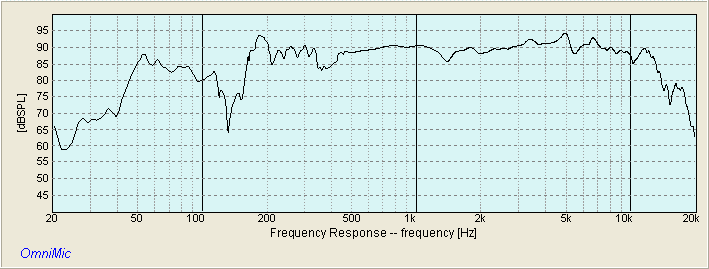 Fig 1 – Satori MW16P-4 RAW Frequency Response • Baffle Width=9-1/2″
Fig 1 – Satori MW16P-4 RAW Frequency Response • Baffle Width=9-1/2″ Fig 2 – SB Acoustics MW16P-4 Frequency Response
Fig 2 – SB Acoustics MW16P-4 Frequency Response Fig 3 – Satori MW16P-4 modeling in an 18 liters bass reflex box
Fig 3 – Satori MW16P-4 modeling in an 18 liters bass reflex box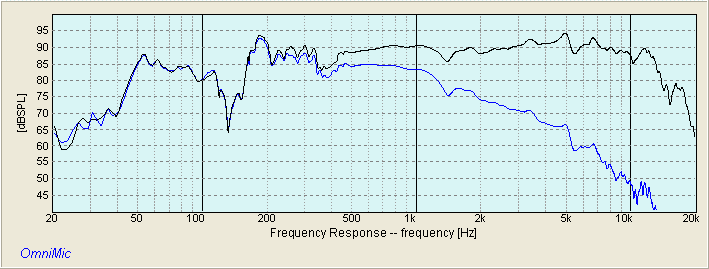
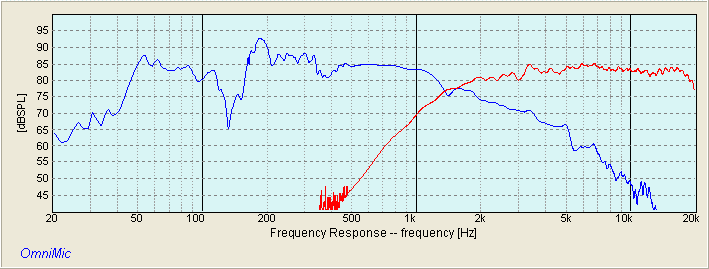 Fig 5 – Satori MW16P-4
Fig 5 – Satori MW16P-4  Fig 6 – Thrush Passband
Fig 6 – Thrush Passband Fig 7 – Thrush Frequency Response
Fig 7 – Thrush Frequency Response Fig 8 – Thrush Null
Fig 8 – Thrush Null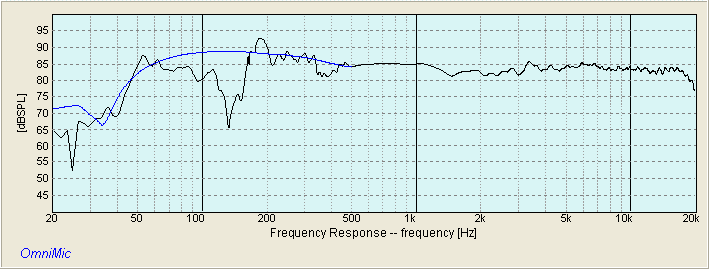 Fig 9 – Thrush Nearfield
Fig 9 – Thrush Nearfield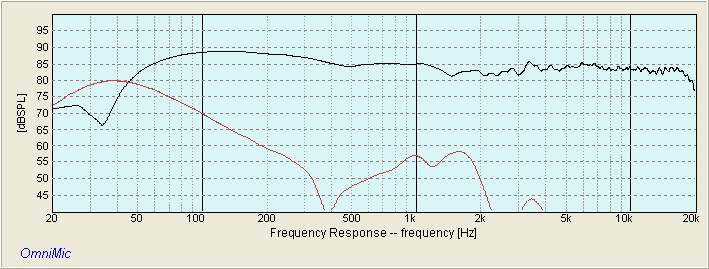 Fig 10 – Thrush Port
Fig 10 – Thrush Port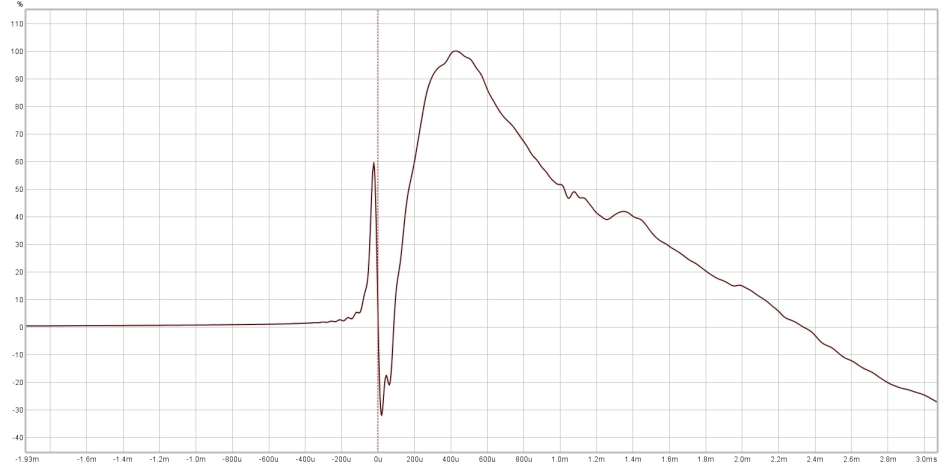 Fig 11 – Thrush Step Response
Fig 11 – Thrush Step Response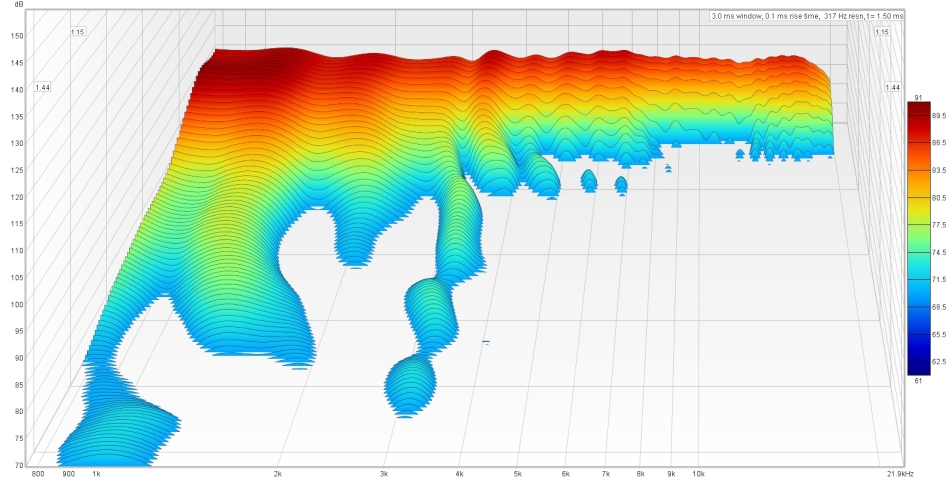 Fig 12 – Thrush Waterfall
Fig 12 – Thrush Waterfall Fig 13 – Thrush Toneburst Energy Storage
Fig 13 – Thrush Toneburst Energy Storage Fig 14 – Thrush Spectrogram
Fig 14 – Thrush Spectrogram Fig 15 – Thrush Impedance
Fig 15 – Thrush Impedance